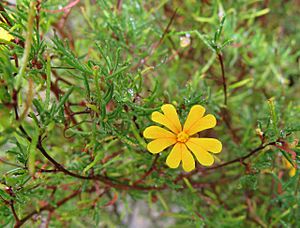Star guinea flower facts for kids
Quick facts for kids Star guinea flower |
|
|---|---|
 |
|
| Scientific classification | |
| Genus: |
Hibbertia
|
| Species: |
stellaris
|
| Synonyms | |
|
Hibbertia tenuiramea Steud. |
|
Hibbertia stellaris, also known as the star guinea flower or orange stars, is a beautiful plant with bright orange flowers. It grows close to the ground in the southwestern part of Australia.
Even though it naturally grows in wet, swampy areas, this plant needs soil that drains water well when people grow it in gardens. This is because it is very sensitive to a plant disease called phytophthora, which can harm its roots.
What it Looks Like
The star guinea flower is a small shrub that usually grows about 30 to 70 centimeters (about 1 to 2.3 feet) tall. It can spread out to be 30 to 60 centimeters wide. Its stems often have a reddish color.
The leaves are long and narrow, sometimes shaped like a small spoon. They are about 1.5 to 2.5 centimeters long. The bright orange flowers usually bloom from August to February. Some plants found further north might have flowers that are a bit more yellowish.
Plant Name and History
The name Hibbertia stellaris was given to this plant by an Austrian botanist named Stephan Endlicher in 1837. He found a sample of the plant near the Swan River in Australia.
The word stellaris comes from the Latin word "stella," which means "star." This name was chosen because the flowers look like little stars. Another botanist, Ernst Gottlieb von Steudel, also described a similar plant in 1845, but later it was found to be the same as Hibbertia stellaris.
Where it Grows
You can find the star guinea flower in many different areas across Western Australia. It is not a rare or endangered plant, meaning there are plenty of them in nature.
How to Grow it
The star guinea flower is a popular plant for gardens because of its amazing bright orange flowers. However, it often doesn't live very long when planted directly in the ground, usually less than 18 months.
It tends to live longer if you grow it in pots or hanging baskets. This plant can also handle a little bit of frost. Plants that get a lot of sunshine will have more flowers, but they might not live as long as those in partial shade.
It's quite easy to grow new plants from cuttings. The best time to take cuttings is in spring, after the plant has finished flowering. It grows best in sandy soil that is a bit acidic and has water underneath, like in a saucer or on a special mat that keeps it moist.

